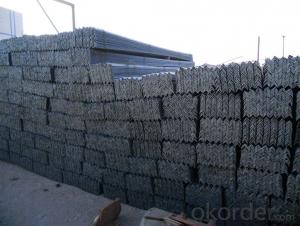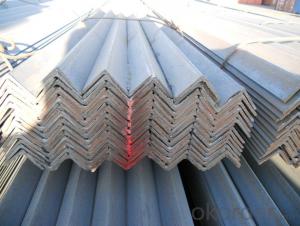HOT ROLLED STEEL ENGLE BAR EQUAL ENGLE BAR UNEQUAL BAR
- Loading Port:
- Tianjin
- Payment Terms:
- TT OR LC
- Min Order Qty:
- 50 m.t.
- Supply Capability:
- 20000 m.t./month
OKorder Service Pledge
OKorder Financial Service
You Might Also Like
Product Description:
Specifications of Angle Steel
1. Invoicing on theoretical weight or actual weight as customer request
2. Length: 6m, 9m, 12m as following table
3. Sizes

Sizes: 25mm-250mm | ||
a*t | ||
25*2.5-4.0 | 70*6.0-9.0 | 130*9.0-15 |
30*2.5-6.6 | 75*6.0-9.0 | 140*10-14 |
36*3.0-5.0 | 80*5.0-10 | 150*10-20 |
38*2.3-6.0 | 90*7.0-10 | 160*10-16 |
40*3.0-5.0 | 100*6.0-12 | 175*12-15 |
45*4.0-6.0 | 110*8.0-10 | 180*12-18 |
50*4.0-6.0 | 120*6.0-15 | 200*14-25 |
60*4.0-8.0 | 125*8.0-14 | 250*25 |
5. Payment terms:
1).100% irrevocable L/C at sight.
2).30% T/T prepaid and the balance against the copy of B/L.
3).30% T/T prepaid and the balance against L/C
6.Material details:
Alloy No | Grade | Element (%) | |||||
C | Mn | S | P | Si | |||
|
|
|
|
|
|
| |
Q235 | B | 0.12—0.20 | 0.3—0.7 | ≤0.045 | ≤0.045 | ≤0.3 | |
|
|
|
|
|
|
| |
Alloy No | Grade | Yielding strength point( Mpa) | |||||
Thickness (mm) | |||||||
≤16 | >16--40 | >40--60 | >60--100 | ||||
≥ | |||||||
|
|
|
|
|
| ||
Q235 | B | 235 | 225 | 215 | 205 | ||
Alloy No | Grade | Tensile strength (Mpa) | Elongation after fracture (%) | ||||
Thickness (mm) | |||||||
| ≤16 | >16--40 | >40--60 | >60--100 | |||
≥ | |||||||
|
|
|
|
|
|
| |
Q235 | B | 375--500 | 26 | 25 | 24 | 23 | |
Usage & Applications of Angle Steel
According to the needs of different structures, Angle can compose to different force support component, and also can be the connections between components. It is widely used in various building structures and engineering structures such as roof beams, bridges, transmission towers, hoisting machinery and transport machinery, ships, industrial furnaces, reaction tower, container frame and warehouse etc.
Packaging & Delivery of Angle Steel
1. Packing: it is nude packed in bundles by steel wire rod
2. Bundle weight: not more than 3.5MT for bulk vessel; less than 3 MT for container load
3. Marks:
Color marking: There will be color marking on both end of the bundle for the cargo delivered by bulk vessel. That makes it easily to distinguish at the destination port.
Tag mark: there will be tag mark tied up on the bundles. The information usually including supplier logo and name, product name, made in China, shipping marks and other information request by the customer.
If loading by container the marking is not needed, but we will prepare it as customer request.
Production flow of Angle Steel
Material prepare (billet) —heat up—rough rolling—precision rolling—cooling—packing—storage and transportation
- Q:How do you calculate the weight-bearing capacity of a steel angle?
- To calculate the weight-bearing capacity of a steel angle, you need to consider its dimensions, material properties, and loading conditions. The weight-bearing capacity can be calculated using engineering formulas and techniques such as the Euler formula or the AISC Manual. These calculations take into account factors like the cross-sectional area, moment of inertia, and the applied loads to determine the maximum load the steel angle can support without failure.
- Q:Are steel angles suitable for architectural applications?
- Yes, steel angles are suitable for architectural applications. They are commonly used in construction projects to provide structural support, such as in building frames, facades, and bridges. Steel angles offer excellent strength and durability, making them a reliable choice for architects seeking a versatile and long-lasting material for their designs.
- Q:Can steel angles be used for framing or supporting exterior façade elements?
- Yes, steel angles can be used for framing or supporting exterior façade elements. Steel angles are commonly used in construction for their strength and durability. They provide a stable and reliable support system for various architectural elements, including exterior façade elements. Steel angles can be used to frame windows, doors, and other openings in the exterior walls. They can also be used to reinforce and support the weight of exterior cladding materials such as stone, glass, or metal panels. Steel angles are versatile and can be easily customized to fit the specific requirements of the project. They are often preferred in commercial and industrial buildings where structural stability is of utmost importance.
- Q:How are steel angles protected against impact damage?
- To safeguard steel angles from impact damage, there are several methods available. One popular approach involves utilizing specialized coatings or paints that have been engineered to absorb and disperse the force of an impact, thus minimizing the resulting harm. These coatings can be easily applied to the surface of the steel angles, providing an additional layer of protection. Another option is to attach rubber or plastic bumper guards to the edges or corners of the steel angles. These guards function as a buffer, absorbing the energy from an impact and preventing direct contact between the steel angle and the object causing the impact. This effectively reduces the risk of denting or deformation. In certain cases, it may be necessary to reinforce steel angles with additional structural elements, such as bracing or stiffeners, to enhance their resistance to impact damage. By doing so, the force from an impact can be more evenly distributed across the structure, minimizing the likelihood of localized damage. In addition, proper installation and maintenance practices play a critical role in safeguarding steel angles against impact damage. It is crucial to ensure that the angles are securely fastened and regularly inspected for any signs of wear or damage. This proactive approach helps identify potential issues before they escalate into more significant problems. In summary, the combination of impact-resistant coatings, bumper guards, structural reinforcements, and diligent maintenance can effectively protect steel angles from impact damage. This not only extends their lifespan but also ensures their structural integrity.
- Q:What is the angle iron back machine?
- With the development of the power industry, the manufacturing level of the power tower is becoming more and more demanding, and the planer processing method can not meet the requirements of production. The company's own design and manufacture of "CB2512" shovel back machine, the use of high-speed milling principle, used for angle steel shovel back process, the tower is the production of angle steel shovel back the first choice of equipment
- Q:Can steel angles be used for framing windows?
- Indeed, framing windows with steel angles is a viable option. Widely employed in construction, steel angles offer supplementary structural support and stability as window frames. Their durability, strength, and ability to resist warping or bending make them well-suited for this task. Moreover, steel angles can be effortlessly tailored and modified to match the precise measurements and specifications of the window frame, ensuring a secure and accurate installation.
- Q:What are the common lengths available for steel angles?
- The manufacturer and supplier determine the available lengths for steel angles, which can differ. Nevertheless, standard lengths are generally found in the market. These lengths usually span from 10 feet (3.048 meters) to 20 feet (6.096 meters). While some manufacturers may offer lengths that are longer or shorter depending on customer demands, the aforementioned lengths are commonly encountered in the industry. To ensure accurate information regarding the available lengths for steel angles, it is vital to consult the specific manufacturer or supplier, as they may offer various options tailored to different applications and customer requirements.
- Q:How do steel angles perform under dynamic loads?
- Steel angles generally perform well under dynamic loads due to their inherent strength and durability. The structural shape of steel angles, characterized by their L-shaped cross-section, provides excellent resistance to bending and torsional forces. This design allows them to efficiently distribute dynamic loads and resist deformation, making them suitable for various applications in construction, engineering, and manufacturing industries. However, the specific performance of steel angles under dynamic loads can vary depending on factors such as the grade and quality of the steel, the magnitude and frequency of the dynamic load, and the overall design and reinforcement of the structure.
- Q:How do steel angles perform under wind loads?
- Structural support and stability are provided by steel angles commonly used in construction. The reliability and effectiveness of steel angles in withstanding wind loads have been proven. The shape and design of steel angles enable them to resist the force exerted by wind, preventing any notable deformation or failure. Under wind loads, the force is evenly distributed along the length of steel angles, transferring it to other connected structural elements. This minimizes the potential for localized stress concentrations and guarantees the overall stability of the structure. Steel angles possess high strength and stiffness, enabling them to resist bending and twisting forces caused by wind. This is especially crucial in areas prone to high wind speeds or in tall buildings where wind loads can be more substantial. The rigidity of steel angles ensures the structure's integrity and prevents excessive deflection or deformation. Additionally, steel angles can be easily connected to other structural components using various methods such as welding, bolting, or riveting. This allows for a secure and reliable connection that can endure wind loads without compromising the overall strength and stability of the structure. To summarize, steel angles excel under wind loads due to their shape, strength, and rigidity. They efficiently distribute wind forces and maintain structural stability, making them a dependable choice for construction projects in wind-prone areas or for structures requiring significant wind load resistance.
- Q:How do steel angles perform in terms of energy efficiency?
- Steel angles are not directly associated with energy efficiency. Energy efficiency is typically evaluated based on factors such as insulation, building design, and the use of energy-efficient appliances or systems. However, steel angles can be used in construction projects to provide structural support, which indirectly contributes to the overall energy efficiency of a building by ensuring its stability and durability.
1. Manufacturer Overview |
|
|---|---|
| Location | |
| Year Established | |
| Annual Output Value | |
| Main Markets | |
| Company Certifications | |
2. Manufacturer Certificates |
|
|---|---|
| a) Certification Name | |
| Range | |
| Reference | |
| Validity Period | |
3. Manufacturer Capability |
|
|---|---|
| a)Trade Capacity | |
| Nearest Port | |
| Export Percentage | |
| No.of Employees in Trade Department | |
| Language Spoken: | |
| b)Factory Information | |
| Factory Size: | |
| No. of Production Lines | |
| Contract Manufacturing | |
| Product Price Range | |
Send your message to us
HOT ROLLED STEEL ENGLE BAR EQUAL ENGLE BAR UNEQUAL BAR
- Loading Port:
- Tianjin
- Payment Terms:
- TT OR LC
- Min Order Qty:
- 50 m.t.
- Supply Capability:
- 20000 m.t./month
OKorder Service Pledge
OKorder Financial Service
Similar products
New products
Hot products
Hot Searches
Related keywords


























